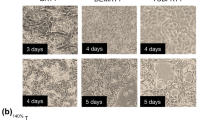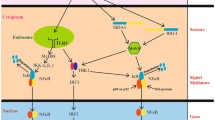Abstract
European bat lyssaviruses (EBLV) types 1 and 2 are closely related to classical rabies virus (RABV), and are capable of causing rabies in terrestrial mammals, including humans. The authors have investigated the murine host innate immune response in the brain, salivary gland, spinal cord, and blood, following peripheral inoculation with EBLV-2. In the brain, increases in Toll-like receptor-3 (TLR-3) transcript preceded overt disease, with a range of inflammatory gene transcripts increasing during the clinical stage of infection. This included transcripts for interleukin-6 (IL-6), interferon-γ (IFN-γ), and CXC chemokine ligand 10 (CXCL10). In the salivary gland, there was a small but significant increase of CXCL10 gene transcript and a limited increase in 2′–5′ oligoadenylate synthetase (2′-5′ OAS1) transcript. In the blood, there was an increase in levels of IFN-γ and virus-neutralizing antibodies (VNAs) were detected prior to the appearance of clinical signs. These changes were associated with severe lymphocyte infiltration observed within the spinal cord and dorsal root ganglia (DRG), which was dominated by T lymphocytes and associated with widespread inflammatory changes. The authors speculate that the increase of inflammatory cytokines and chemokines in response to EBLV-2 infection leads to a dramatic increase in T-cell infiltration and provides evidence for a robust immune response to lyssavirus infection that may not commonly occur in RABV infection.
Similar content being viewed by others
References
Alexopoulou L, Holt AC, Medzhitov R, Flavell R (2001). Recognition of double-stranded RNA and activation of NF-κB by Toll-like receptor 3. Nature 413: 732–738.
Bonecchi R, Bianchi G, Bordignon PP, D’Ambrosio D, Lang R, Borsatti A, Sozzani S, Allavena P, Gray PA, Mantovani A, Sinigaglia F (1998). Differential expression of chemokine receptors and chemotactic responsiveness of Type 1 T helper cells (Th1s) and Th2s. J Exp Med 187: 129–134.
Brookes SM, Aegerter JN, Smith GC, Healy D., Joliffe TA, Swift SM, Mackie IJ, Pritchand JS, Pacey PA, Moore NP, Focks AK (2005a). European bat lyssaviruses in Scottish bats. Emerg Infect Dis 11: 572–578.
Brookes SM, Klopfleisch R, Muller T, Healy DM, Teifke J, Lange E, Kliemt J, Johnson N, Finnegan CJ, Johnson L, Kaden V, Vos A Fooks, AR (2007). Susceptibility of sheep to European bat lyssavirus types 1 and 2 infection: A clinical pathogenesis study. Vet Microbiol 125: 210–223.
Brookes SM, Parsons G, Johnson N, McElhinney LM, Fooks AR (2005b). Rabies human diploid vaccine elicits cross-neutralizing and cross-protecting immune responses against European and Australian bat lyssaviruses. Vaccine 23: 4101–4109.
Brzozka K, Finke S, Conzelmann K-K (2005). Identification of the rabies virus alpha/beta interferon antagonist: phosphoprotein P interferes with phosphorylation of interferon regulatory factor 3. J Virol 79: 7673–7681.
Conzelmann K-K (2005). Transcriptional activation of alpha/beta interferon genes: interference by nonsegmented negative-strand RNA viruses. J Virol 79: 5241–5248.
Fooks AR, Brookes SM, Johnson N, McElhinney LM, Hutson AM (2003a). Review article: European bat lyssaviruses: an emerging zoonoses. Epidemiol Infect 131: 1029–1039.
Fooks AR, McElhinney LM, Marston DA, Selden D, Joliffe TA, Wakeley PR, Johnson N, Brookes SM (2004). Identification of a European bat lyssavirus type 2 in a Daubenton’s bat found in Staines, Surrey, UK. VetRec 155: 434–435.
Fooks AR, McElhinney LM, Pounder DJ, Finnegan CJ, Mansfield K, Johnson N, Brookes SM, Parsons G, White K, McIntyre PG, Nathwani D (2003b). Case report: Isolation of a European bat lyssavirus type 2a from a fatal human case of rabies encephalitis. J Med Virol 71: 281–289.
Haller O, Kochs G, Weber F (2006). The interferon response circuit: Induction and suppression by pathogenic viruses. Virology 344: 119–130.
Heaton PR, Johnstone P, McElhinney LM, Cowley R, O’Sullivan E, Whitby JE (1997). Heminested PCR assay for detection of six genotypes of rabies and rabies-related viruses. J Clin Microbiol 35: 2762–2766.
Hornung V, Ellegast J, Kim S, Brzózka K, Jung A, Kato H, Poeck H, Akira S, Conzelmann K-K, Schlee M, Endres S, Hartmann G (2006). 5′-Triphosphate RNA is the ligand for RIG-I. Science 314: 994–997.
Jackson AC, Reimer DL, Ludwin SK (1989). Spontaneous recovery from the encephalomyelitis in mice caused by street rabies virus. Neuropathol Appl Neurobiol 15: 459–475.
Jackson AC, Rossiter JP, Lafon M (2006). Expression of Toll-like receptor 3 in in the human cerebellar cortex in rabies, herpes simplex encephalitis, and other neurological diseases in humans. J NeuroVirol 12: 229–234.
Johnson N, Mansfield KL, Hicks D, Nunez A, Healy D, Brookes SM, McKimmie CS, Fazakerley JK, Fooks AR (2008). Inflammatory responses in the nervous system of mice infected with a street isolate of rabies virus. In Towards the Elimination of Rabies in Eurasia. Dev Biol 131. Doclet B, Fooks AR, Muller T, Torclo N, Scientific and Technical Department of the OIE (eds). Karger, Basel, pp. 65–72.
Johnson N, McKimmie CS, Mansfield KL, Wakeley PR, Brookes SM, Fazakerley JK, Fooks AR (2006). Lyssavirus infection activates interferon gene expression in the brain. J Gen Virol 87: 2663–2667.
Johnson N, Selden D, Parsons G, Healy D, Brookes SM, McElhinney LM, Hutson AM, Fooks AR (2003). Isolation of a European bat lyssavirus type 2 from a Daubenton’s bat in the United Kingdom. Vet Rec 152: 383–387.
Lacroix-Lamandé S, Mancassola R, Naciri M, Laurent F (2002). Role of gamma interferon in chemokine expression in the ileum of mice and in a murine intestinal epithelial cell line after Cryptosporidium parvum infection. Infect Immun 70: 2090–2099.
McKimmie CS, Johnson N, Fooks AR, Fazakerley JK (2005). Viruses selectively upregulate Toll-like receptors in the central nervous system. Biochem Biophys Res Commun 336: 925–933.
Murray LJ, Lee R, Martens C (1990). In vivo cytokine gene expression in T cell subsets of the autoimmune MRL/Mp-lpr/lpr mouse. Eur J Immunol 20: 163–170.
Nadin-Davis SA (2007). Molecular epidemiology. In: Rabies, 2 ed. Jackson AC, Wunner WH (eds). London: Elsevier Academic Press pp 69–122.
Nakamichi K, Saiki M, Sawada M, Takayama-Ito M, Yamamuro Y, Morimoto K, Kurane I (2005). Rabies virus-induced activation of mitogen-activated protein kinase and NF-κB signalling pathways regulates expression of CXC and CC chemokine ligands in microglia. J Virol 79: 11801–11812.
Préhaud C, Mégret F, Lafage M, Lafon M (2005). Virus infection switches TLR-3-positive human neurons to become strong producers of beta interferon. J Virol 79: 12893–12904.
Prosniak M, Hooper DC, Dietzschold B, Koprowski H (2001). Effect of rabies virus infection on gene expression in mouse brain. Proc Natl Acad Sci U S A 98: 2758–2763.
Rossi D, Zlotnik A (2000). The biology of chemokines and their receptors. Ann Rev Immunol 18: 217–242.
Roy A, Phares TW, Koprowski H, Hooper DG (2007). Failure to open the blood-brain barriers and deliver immune effectors to central nervous system tissues leads to the lethal outcome of silver-haired bat rabies virus infection. J Virol 81: 1110–1118.
Sen GC, Sarker SN (2005). Transcriptional signalling by double-stranded RNA: role of TLR3. Cytokine Growth Factor Rev 16: 1–14.
Sugamata M, Miyazawa M, Mori S, Spangrude GJ, Ewalt LC, Lodmell DL (1992). Paralysis of street rabies virus-infected mice is dependent on T lymphocytes. J Virol 66: 1252–1260.
Vos A, Muller T, Cox J, Neubert L, Fooks AR (2004). Susceptibility of ferrets (Mustela putorius furo) to experimentally induced rabies with European bat lyssaviruses (EBLV). J Med Vet B Infect Dis Vet Pub Health 51: 55–60.
Wang ZW, Sarmento L, Wang Y, Li X-Q, Dhingra V, Tseggai T, Jiang B, Fu ZF (2005). Attenuated rabies virus activates, while pathogenic rabies virus evades, the host innate immune responses in the central nervous system. J Virol 79: 12554–12565.
Yoneyama M, Kikuchi M, Natsukawa T, Shinobu N, Imaizumi T, Miyagishi M, Taira K, Akira S, Fujita T (2004). The RNA helicase RIG-I has an essential function in double-stranded RNA-induced innate antiviral responses. Nature Immunol 5: 730–737.
Author information
Authors and Affiliations
Corresponding author
Additional information
This study was funded by the Department for Environment, Food and Rural Affairs (DEFRA), UK (project SE0524).
The rights in a Contribution prepared by an employee of the U.K. government department, agency, or other Crown body belong to the Crown and are not subject to United States copyright law.
Rights and permissions
About this article
Cite this article
Mansfield, K.L., Johnson, N., Nuñez, A. et al. Up-regulation of chemokine gene transcripts and T-cell infiltration into the central nervous system and dorsal root ganglia are characteristics of experimental European bat lyssavirus type 2 infection of mice. Journal of NeuroVirology 14, 218–228 (2008). https://doi.org/10.1080/13550280802008297
Received:
Revised:
Accepted:
Issue Date:
DOI: https://doi.org/10.1080/13550280802008297




